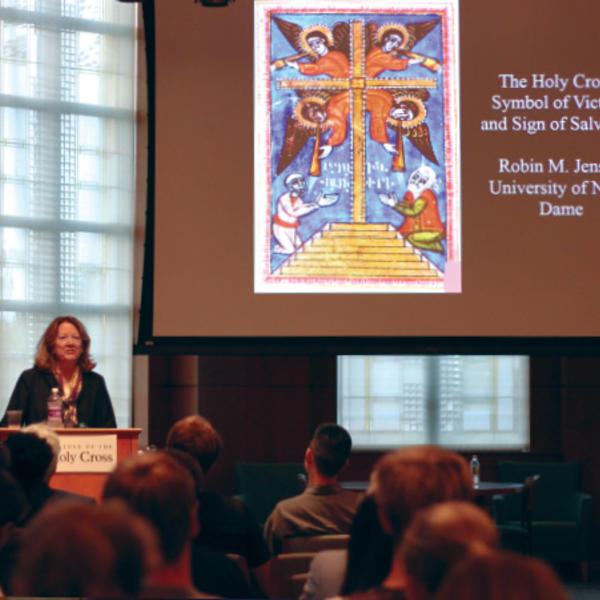Today, images of the cross and crucifixion are synonymous with Christianity — but that has not always been the case.
"Art historians have been unable to identify an explicitly Christian crucifix prior to the fourth or even the fifth century, and then only a few rare examples before the sixth. Even a plain Christian cross symbol is virtually missing in Christian art much before the middle of the fourth century," shared Robin Jensen, Patrick O'Brien Professor of Theology at the University of Notre Dame, at a lecture examining the history, art and meanings behind the College's namesake a few days after the Feast of the Holy Cross.
Some scholars believe the lack of cross or crucifix imagery implies that Christians of the first three centuries were not as focused on the matter, purpose or meaning of Christ's crucifixion, but rather on his message of love, justice and a promised paradise. Jensen disagrees.
"As a historian who works in both early Christian texts and material culture, I cannot avoid the evidence that ancient Christian writers in fact regarded the cross and Christ's crucifixion as a core event in salvation history," she explained. "We have extensive evidence that early Christians went about explaining, defending and even proclaiming the crucifixion."
It wasn't until the middle of the fourth century that an unambiguous Christian cross began to make a frequent appearance, alongside the Christogram, a symbol made up of the interlocked Greek letters chi and rho, the first two letters of Christ's name.
Without question, the Christogram was initially associated with the Emperor Constantine, to whom the symbol appeared in a dream or waking vision just before a major military victory, Jensen shared. The use of the images spread under Constantine, who regarded the cross as his personal protective insignia. "Both the Christogram and the simple cross now start to appear in a variety of contexts that are clearly imperial and specifically military in character," she said.
Within a few years, however, the cross and Christogram were included in scenes of the Passion story — still not showing Jesus' crucifixion — as symbols of Christ's victory over death, completely removed from any imperial context.
"If the cross hadn't had the association with Constantine's victory, it wouldn't necessarily carry the meaning of victory," she noted, pointing to this as a strong example of how images transform themselves.
Images of the crucifixion come into prominence after Constantine's mother, Helena, identified the site of the crucifixion and relics of the true cross were discovered. The earliest depictions of Jesus on the cross were found within Constantine's shrine of the Holy Sepulchre in Jerusalem, built on the site identified by his mother.
From then on, cross and crucifixion images became steady motifs within Christian visual culture. In the few centuries that followed, their presentation and associations continued to evolve. Some depictions linked Jesus' cross to the Edenic tree of life, bringing the story of original sin full circle to salvation, while crucifixion depictions shifted from an emphasis on Christ's victory over death to his participation in human suffering.
This changing, enriched visual repertoire, said Jensen, "expanded the possibilities and potentialities of the Holy Cross as a rich and incredibly complicated Christian symbol."
The lecture was presented as part of the College's ongoing celebration of its 175th anniversary and one of the Deitchman Family Lectures on Religion and Modernity, sponsored by the Rev. Michael C. McFarland, S.J. Center for Religion, Ethics and Culture.
Written by Evangelia Stefanakos '14 for the Winter 2019 issue of Holy Cross Magazine.
About Holy Cross Magazine
Holy Cross Magazine (HCM) is the quarterly alumni publication of the College of the Holy Cross. The award-winning publication is mailed to alumni and friends of the College and includes intriguing profiles, make-you-think features, alumni news, exclusive photos and more. Visit magazine.holycross.edu/about to contact HCM, submit alumni class notes, milestones, or letters to the editor.
For more photos, history and events celebrating Holy Cross’ 175th anniversary, visit the anniversary website.
'A Symbol of Victory and Sign of Salvation' Lecture Explores College's Namesake

Inside the history, art and meanings behind the Holy Cross as part of the College's 175th anniversary celebrations
Read Time
3 Minutes

